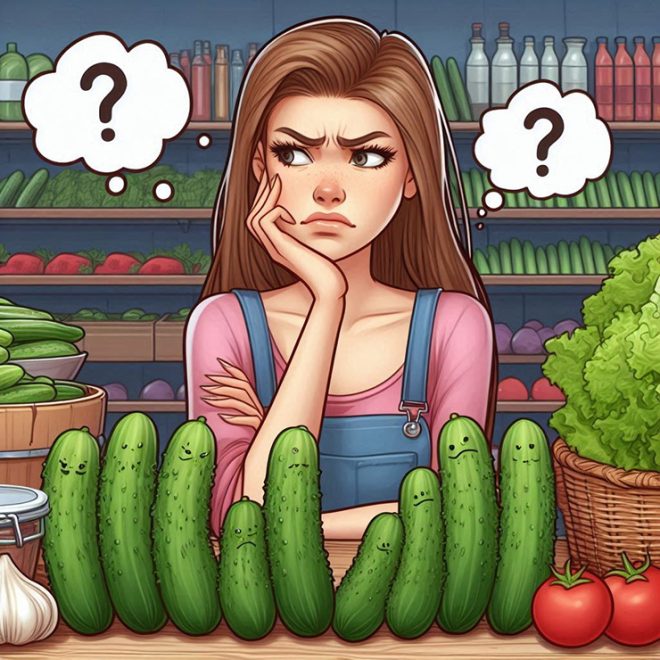Last year, I grew the ugliest cucumbers of all time, I’m pretty sure. They were misshapen, bulging in the wrong places, and the most odd shade of orange. I don’t know exactly what went wrong. I could have spent a fair amount of time checking the moisture or pH levels of the soil, fertilizing or neutralizing. In our case, I think we may actually have waited too long to harvest. The unique specimens made us smile as we pondered the mysteries of life.
We’re fortunate that our small container garden is just a supplement to regular shopping trips, and that we don’t depend on my green thumb. It’s important to me to teach my kids how to grow things. There are so many benefits—from learning to be gentle with the delicate new sprouts, to exercising patience in waiting for the green tomatoes to turn yellow, orange, and, then, finally, red. We see that well-grown healthy food can be just as tasty as a candy bar. We get fresh snacks without having to leave our home. We learn that a good harvest depends on so many other creatures—the folks who prepared the seeds, the pollinators that turn flowers into fruits. We are but a small part of the entire system. Perhaps most importantly, my kids needed to see that I could try and fail, and simply try again.

Regarding the overgrown cucumbers, they weren’t fit for consumption at that point, but we eventually made an assortment of gourds on our porch to welcome Fall, and the misfit cukes blended beautifully into the tableau, a happy accident indeed! And we learned that, on future attempts, we need to keep a closer eye on the garden, and not miss the picking window.
This year, I was gifted a planting box to set up on our porch. I carefully selected the seeds and sketched out the design in careful rows, all edibles—lettuce, spinach, basil, oregano, thyme and dill. To reinforce my son’s science lessons, we inventoried the required three S’s—seed, sun, and soil—and we added some water. I also worked in some of the compost from our backyard bin.
What I hadn’t considered was what might be in the compost that hadn’t yet decomposed. After the first lettuce harvest, I noticed some heart-shaped leaves sprouting from a sturdy stem. Having gotten familiar with cucumber sprouts, I thought I must have gotten sloppy and let a couple of those seeds mix in. As the plant grew, though, it sprouted not the dainty little yellow cucumber blossoms, but U-shaped cups that bloomed huge and orange … the color of, well, a pumpkin. Yes, we have some volunteer pumpkins in our garden box. But what to do about it?
Having already harvested a couple of rounds of the lettuce, letting my kids have the pleasure of snapping off fresh snacks right from the stem, I decided to let the pumpkins sprawl. Only time will tell what we end up with. The leaves and blooms are multiplying quickly, shoots roaming around to enable its impressive rapid expansion. It’s amazing to think that such a large plant has unfurled from something the size of my pinky nail. I don’t know if the planter box will be large enough to support the growth of a full-size pumpkin. Even if it’s not, it’s something we can log our experience for next year.
“Success” and “failure” have a lot to do with perception. I think about the “failures” that have existed that have brought us to this precise moment. They may be crushing at the time, but hold value that we can’t even know until decades later. My ancestors tried life out West in the 1860s, but soon gave up on life in Iowa and returned to Pennsylvania. It was in Pennsylvania that my great-great grandmother Cora met her husband Elmer, married, and started their family. Their union has created 177 descendants so far, and the family keeps growing. Maybe they had to travel far away to realize how right the place they’d left had really been.
A garden is a place where all the elements of our care and environment combine: our seeds and soil, our love, our tears, the rays of the sun, whatever’s in the ever-changing atmosphere: ash, smoke, acid rain, the scent of barbecues, the whistles of distant trains, reminding us that there are many other destinations, but we are here. We grow not in a bubble, but as the culmination of all the input we’ve received. And there’s no failure, because, without any particular piece of the puzzle, we wouldn’t be who we are today. ❖
About the Author: Jessica Manack lives in Pittsburgh, Pennsylvania, where she raises children and vegetables at a 100-year-old home in the city’s historic North Side.


